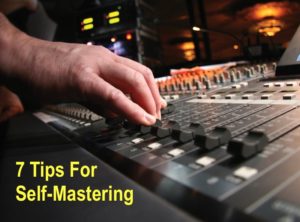- in Book Excerpt , Engineering , Production by Bobby Owsinski
- |
- 2 comments
7 Self-Mastering Tips For When You Can’t Hire A Mastering Engineer
 Let’s face it, recording budgets are tight these days and we can’t always send our final mixes to a true mastering engineer. With so many of the same tools that mastering engineers use now available to every mixer, it’s now possible to do a pretty good self-mastering job. If that’s your situation, it’s best to follow these following 7 steps excerpted from the latest edition of my Music Producer’s Handbook.
Let’s face it, recording budgets are tight these days and we can’t always send our final mixes to a true mastering engineer. With so many of the same tools that mastering engineers use now available to every mixer, it’s now possible to do a pretty good self-mastering job. If that’s your situation, it’s best to follow these following 7 steps excerpted from the latest edition of my Music Producer’s Handbook.
1. Don’t master on the same speakers you mix on. If you do, you won’t be able to make up for the deficiencies of the speaker.
2. Listen to other songs that you like before you even touch an EQ parameter. The more songs you listen to, the better. You need a reference point to compare your work with, and listening to other songs will prevent you from over-EQ’ing. EQ’ing is usually the stage when engineers who are mastering their own mixes get in trouble. There’s a tendency to overcompensate with the EQ, adding huge amounts (usually of bottom end) that wreck the frequency balance of the song completely.
3. A little goes a long way. If you feel that you need to add more than 2 or 3 dB, you’re better off remixing! That’s what the pros do. It’s not uncommon at all for a pro mastering engineer to call up a mixer, tell him where he’s off, and ask him to do it again.
4. Be careful not to over-compress or over-limit your song. This can lead to hypercompression. Instead of making a song louder, hypercompression sucks all the dynamics out of it, making it lifeless and fatiguing to listen to.
5. Constantly compare your mastering job to other songs that you like the sound of. Doing this is one of the best ways to help you hear whether and how you’re getting off track.
6. Concentrate on making all the songs sound the same in relative level and tone. This is one of the key operations in mastering a collection of songs like an album. The idea is to get them to all sound as though they’re at the same volume. It’s pretty common for mixes to sound different from song to song even if they’re done by the same engineer with the same gear. It’s your job to make the listener think that the songs were all done on the same day in the same way. They’ve got to sound as close to each other in volume as you can get them, or at least close enough so as not to stand out.
7. Finish the songs. Edit out count-offs and glitches, fix fades, and create spreads for CDs and vinyl records.
If you see a self-mastering job on the horizon, you’ll find that your results will be far closer to that of a mastering engineer if you follow these tips.
You can read more from The Music Producer’s Handbook and my other books on the excerpt section of bobbyowsinski.com.

